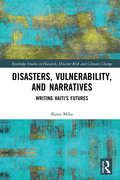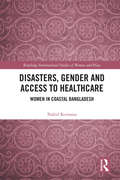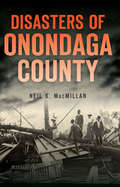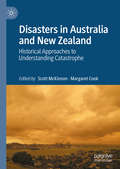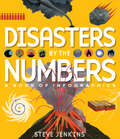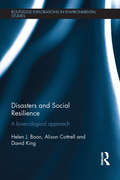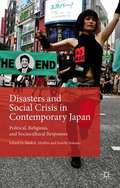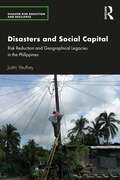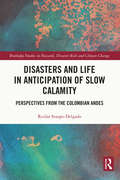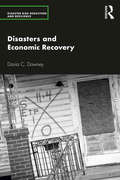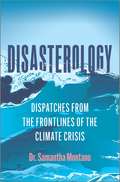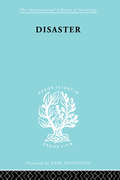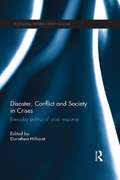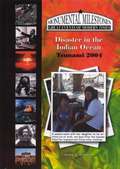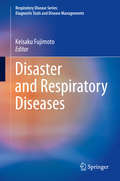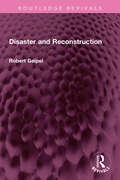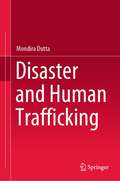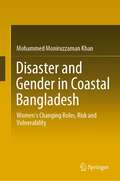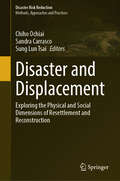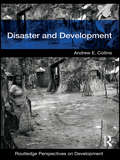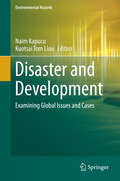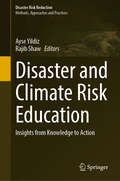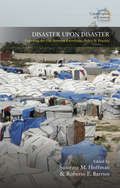- Table View
- List View
Disasters, Vulnerability, and Narratives: Writing Haiti’s Futures (Routledge Studies in Hazards, Disaster Risk and Climate Change)
by Kasia MikaThis book uses narrative responses to the 2010 Haiti earthquake as a starting point for an analysis of notions of disaster, vulnerability, reconstruction and recovery. The turn to a wide range of literary works enables a composite comparative analysis, which encompasses the social, political and individual dimensions of the earthquake. This book focuses on a vision of an open-ended future, otherwise than as a threat or fear. Mika turns to concepts of hinged chronologies, slow healing and remnant dwelling. Weaving theory with attentive close-readings, the book offers an open-ended framework for conceptualising post-disaster recovery and healing. These processes happen at different times and must entail the elimination of compound vulnerabilities that created the disaster in the first place. Challenging characterisations of the region as a continuous catastrophe this book works towards a bold vision of Haiti’s and the Caribbean’s futures. The study shows how narratives can extend some of the key concepts within discipline-bound approaches to disasters, while making an important contribution to the interface between disaster studies, postcolonial ecocriticism and Haitian Studies.
Disasters, Gender and Access to Healthcare: Women in Coastal Bangladesh (Routledge International Studies of Women and Place)
by Nahid RezwanaDisasters, Gender and Access to Healthcare: Women in Coastal Bangladesh emphasizes women’s experiences in cyclone disasters being confined with gendered identity and responsibilities in developing socio-economic conditions with minimum healthcare facilities. The study is situated in the coastal region of Bangladesh, considered as one of the most disaster-prone regions in the world. Bangladesh has been working on disaster management for a long time; however, considering gender perspective, the book reveals gaps in plans and raises serious questions about the successful implementation of healthcare strategies after disasters. The book also describes the pre–during–after disaster periods showing the full picture of a disaster attack in victims’ own words. Case studies of seriously affected victims give the reader an opportunity to understand the situations created for women during a disaster attack in a remote area with poor transport and healthcare facilities. These unique research findings will contribute to the broader context of gender, disaster and health studies. This book will be helpful for university staff and students of different disciplines including Anthropology, Disaster Management, Gender Studies and Geography and South Asian Regional Studies and be invaluable reading for disaster managers, policy makers, aid workers, development partners, NGOs and government, especially in disaster-prone countries.
Disasters of Onondaga County (Disaster)
by Neil K. MacmillanThe city of Syracuse and Onondaga County have a long and storied history of natural and man-made calamity. Although often considered a moderate weather region, Mother Nature has not spared it from destruction. A tornado devastated picturesque Longbranch Park in 1912, and the rare Hurricane Hazel reached Onondaga’s borders in 1954. A fire ravaged Syracuse’s famed Bastable Block building in 1923. During a children’s concert and festival, the floor of the Central Baptist Church collapsed, tragically claiming scores of lives and injuring more than one hundred. Author and historian Neil MacMillan charts the history of Onondaga County catastrophes.
Disasters in Australia and New Zealand: Historical Approaches to Understanding Catastrophe
by Scott McKinnon Margaret CookDisasters in Australia and New Zealand brings together a collection of essays on the history of disasters in both countries. Leading experts provide a timely interrogation of long-held assumptions about the impacts of bushfires, floods, cyclones and earthquakes, exploring the blurred line between nature and culture, asking what are the anthropogenic causes of ‘natural’ disasters? How have disasters been remembered or forgotten? And how have societies over generations responded to or understood disaster? As climate change escalates disaster risk in Australia, New Zealand and around the world, these questions have assumed greater urgency. This unique collection poses a challenge to learn from past experiences and to implement behavioural and policy change. Rich in oral history and archival research, Disasters in Australia and New Zealand offers practical and illuminating insights that will appeal to historians and disaster scholars across multiple disciplines.
Disasters by the Numbers: A Book of Infographics
by Steve JenkinsAn amazing look at Earth&’s natural disasters as seen through numbers, facts, and stunning infographics from Caldecott Honor–winning author-illustrator Steve Jenkins! From Caldecott Honor–winning author-illustrator Steve Jenkins comes an in-depth look at the world's natural disasters, broken down into four distinct categories: earth, weather, life, and space. From timelines of causes and outcomes of each disaster, graphs highlighting humans' effect on the earth, and a text teeming with fresh, unexpected, and accurate information ready for readers to easily devour, Disasters by the Numbers is unmatched and sure to wow fans old and new.
Disasters and Social Resilience: A bioecological approach (Routledge Explorations in Environmental Studies)
by David King Helen J. Boon Alison CottrellThe interconnectedness of communities, organisations, governing bodies, policy and individuals in the field of disaster studies has never been accurately examined or comprehensively modelled. This kind of study is vital for planning policy and emergency responses and assessing individual and community vulnerability, resilience and sustainability as well as mitigation and adaptation to climate change impacts; it therefore deserves attention. Disasters and Social Resilience fills this gap by introducing to the field of disaster studies a fresh methodology and a model for examining and measuring impacts and responses to disasters. Urie Bronfenbrenner’s bioecological systems theory, which is used to look at communities holistically, is outlined and illustrated through a series of chapters, guiding the reader from the theory's underpinnings through research illustrations and applications focused on each level of Bronfenbrenner’s ecosystems, culminating in an integration chapter. The final chapter provides policy recommendations for local and national government bodies and emergency providers to help individuals and communities prepare and withstand the effects of a range of disasters. This book will be of great interest to scholars and students of disaster and emergency management, disaster readiness and risk reduction (DRR), and to scholars and students of more general climate change and sustainability studies.
Disasters and Social Crisis in Contemporary Japan: Political, Religious, And Sociocultural Responses
by Koichi Nakano Mark MullinsJapan was shaken by the 'double disaster' of earthquake and sarin gas attack in 1995, and in 2011 it was hit once again by the 'triple disaster' of earthquake, tsunami, and nuclear meltdown. This international, multi-disciplinary group of scholars examines the state and societal responses to the disasters and social crisis.
Disasters and Social Capital: Risk Reduction and Geographical Legacies in the Philippines (Disaster Risk Reduction and Resilience)
by Justin VeutheyThis book analyzes social capital and preparations for natural hazards in the Philippines. It emphasizes the importance of inequalities, contextualization, and scale, while also underlining the significance of historical and political contexts to better understand social dynamics. Social capital continues to be a debated concept, but it can be useful for thinking about how human societies interact with natural hazards. This book contributes to the growing scientific inquiries which have begun to address the connections between social capital and “natural” disasters. Chapters explore the links between these two fields of knowledge by analyzing the Filipino situation in general, as well as detailing a specific case study of a rural municipality in the Eastern Visayas region. The book’s central argument is that economic inequality is detrimental to social capital which then has negative repercussions on preparing for natural hazards. In an analysis at several geographical scales, Justin shows how inequality, via social capital, makes societies more at risk of having natural hazards turn into disasters. The book argues that a cautious use of the concept of social capital, which is cognizant of the historical and geographical complexities of the context it is applied to, has the potential to improve the way people collectively prevent hazards from turning into disasters. It is essential reading for students, scholars, disaster risk management practitioners, policymakers, and anyone seeking to understand the complexities of climate change, inequality, and crisis resilience.
Disasters and Life in Anticipation of Slow Calamity: Perspectives from the Colombian Andes (Routledge Studies in Hazards, Disaster Risk and Climate Change)
by Reidar Staupe-DelgadoThe book provides insights into community narratives concerning life in the face of creeping calamities through a case study from the Colombian Andes. It sets out to make sense of the lived experience of disasters that are slowly unfolding as well disasters that have not yet occurred. This book explores what it means to live in anticipation of disaster and in anticipation of an uprooting of community, sense of self, and sense of belonging. It questions whether community resilience is a useful concept in the context of slow-onset geological hazards for which few viable solutions are available. The book forces us to think about how resettlement and displacement functions in the context of slow calamities, which presents distinct challenges, mainly related to lower political saliency than what is usually the case in emergencies. The book thus also has implications for how we think about the adverse impacts of climate change. By raising new questions on the nature of disasters and calamities and how we experience them, the book explores the challenges and tensions surrounding governance and governmentality. The inter-disciplinary blend of practice-oriented and conceptual reflections will appeal to academics in postgraduate and postdoctoral research in social sciences, specifically, disaster research, geography, and research fields centred on natural hazards and disasters.
Disasters and Economic Recovery (Disaster Risk Reduction and Resilience)
by Davia C. DowneyDisasters and Economic Recovery provides perspectives on the economic issues that emerge before, during, and after natural disasters in an international context, by assessing the economic development patterns that emerge before and after disaster. This book will provide a historical overview of emergency management policy and previous responses to disasters in each country, as well as the policy learning that occurred in each case leading up to the disasters under analysis. The book highlights four cases: New Orleans; Christchurch, New Zealand; the Japan earthquake and tsunami; and Hurricane Sandy in the Northeastern United States. The book places important focus on the specific collaborative developments unique to the rebuilding of each place’s economy post-disaster. Using time-series data, the book shows the emergence of new industries and job hiring patterns in the immediate aftermath, as well as provides a picture of the economic performance of each country in the years following each event. Looking at the economic development policies pre- and post-disaster, readers will glean important lessons on how to build resilient economies within the disaster framework, highlighting the differences in approaches to rebuilding local economies in places with varying levels of governmental capacity post-disaster to inform policymakers, scholars, and the disaster relief community as they plan their response to future disasters.
Disasters The Biggest Disasters in History From Salt in the Indus Valley to Hurricane Sandy
by Kieron ConnollyDisasters The Biggest Disasters in History From Salt in the Indus Valley to Hurricane Sandy BY Kieron Connolly
Disasterology: Dispatches from the Frontlines of the Climate Crisis
by Samantha MontanoPart memoir, part expert analysis, Disasterology is a passionate and personal account of a country in crisis—one unprepared to deal with the disasters of today and those looming in our future.With temperatures rising and the risk of disasters growing, our world is increasingly vulnerable. Most people see disasters as freak, natural events that are unpredictable and unpreventable. But that simply isn&’t the case – disasters are avoidable, but when they do strike, there are strategic ways to manage the fallout.In Disasterology, Dr. Montano, a disaster researcher, brings readers with her on an eye-opening journey through some of our worst disasters, helping readers make sense of what really happened from a emergency management perspective. She explains why we aren&’t doing enough to prevent or prepare for disasters, the critical role of media, and how our approach to recovery was not designed to serve marginalized communities. Now that climate change is contributing to the disruption of ecosystems and worsening disasters, Dr. Montano offers a preview of what will happen to our communities if we don&’t take aggressive, immediate action. In a section devoted to the COVID-19 pandemic, what is thus far our generation&’s most deadly disaster, she casts light on the many decisions made behind closed doors that failed to protect the public.A deeply moving and timely narrative that draws on Dr. Montano's first-hand experience in emergency management, Disasterology is essential reading for anyone who wants to understand how our country handles disasters, and how we can better face them together.
Disaster: A Psychological Essay (International Library of Sociology)
by Martha WolfensteinFirst Published in 1998. Routledge is an imprint of Taylor & Francis, an informa company.
Disaster, Conflict and Society in Crises: Everyday Politics of Crisis Response (Routledge Humanitarian Studies)
by Dorothea HilhorstHumanitarian crises - resulting from conflict, natural disaster or political collapse – are usually perceived as a complete break from normality, spurring special emergency policies and interventions. In reality, there are many continuities and discontinuities between crisis and normality. What does this mean for our understanding of politics, aid, and local institutions during crises? This book examines this question from a sociological perspective. This book provides a qualitative inquiry into the social and political dynamics of local institutional response, international policy and aid interventions in crises caused by conflict or natural disaster. Emphasising the importance of everyday practices, this book qualitatively unravels the social and political working of policies, aid programmes and local institutions. The first part of the book deals with the social life of politics in crisis. Some of the questions raised are: What is the meaning of human security in practice? How do governments and other actors use crises to securitize – and hence depoliticize - their strategies? The second part of the book deals with the question how local institutions fare under and transform in response to crises. Conflicts and disasters are breakpoints of social order, with a considerable degree of chaos and disruption, but they are also marked by processes of continuity and re-ordering, or the creation of new institutions and linkages. This part of the book focuses on institutions varying from inter-ethnic marriage patterns in Sri Lanka to situation of institutional multiplicity in Angola. The final part of the book concerns the social and political realities of different domains of interventions in crisis, including humanitarian aid, peace-building, disaster risk reduction and safety nets to address chronic food crises. This book gives students and researchers in humanitarian studies, disaster studies, conflict and peace studies as well as humanitarian and military practitioners an invaluable wealth of case studies and unique political science analysis of the humanitarian studies field.
Disaster in the Indian Ocean: Tsunami 2004
by John Albert TorresExamines the devastation caused by the 2004 Indian Ocean Tsunami, the outpouring of charitable response from around the world, and if a similar incident could happen in the United States.
Disaster and Respiratory Diseases (Respiratory Disease Series: Diagnostic Tools And Disease Managements Ser.)
by Keisaku FujimotoThis book provides valuable data on the outbreak, aggravation, treatment and prevention of respiratory diseases based on prior experiences of natural disasters such as earthquakes and tsunamis. Poor hygiene and air pollution can lead to the onset of pneumonia and other respiratory disease, while a lack of medical supplies aggravates existing pulmonary diseases such as chronic obstructive pulmonary disease and asthma. Furthermore, there are cases where those forced to live in cramped conditions, such as cars, following a disaster have developed pulmonary thromboembolism as a result of deep vein thrombosis. The large numbers of patients diagnosed with respiratory diseases make understanding the links between natural disasters and pulmonary disease vital.Disaster and Respiratory Diseases is a valuable resource for all medical staff, including physicians involved in primary care, respiratory medicine and infection control and emergency medicine, as well as respiratory surgeons. It is also useful to national and regional governments concerned about anti-disaster measures.
Disaster and Reconstruction (Routledge Revivals)
by R GeipelOriginally published in 1982 and based on empirical research into the aftermath of the Friuli earthquake in Italy, the book reflects the perspective gained over a period of four years on the event itself and the subsequent response of the local population and national government. Unique insights were gained through one of the largest questionnaire surveys ever undertaken in a disaster situation and important questions are posed concerning the policies of reconstruction. Is a disaster ‘the great equalizer’ and does regional society emerge from it with redistributed power relationships, or are established structures reinforced? Who gets hurt and who benefits? What effects do poverty, regional remoteness from central government and the ethnic and cultural dimensions have on the situation? As a substantial treatment of a major catastrophe in all its aspects, this book will be of interest to students and researchers concerned with the impact of and response to natural hazards. It is based on a unique event, but the findings it reveals are relevant to all major catastrophes.
Disaster and Human Trafficking
by Mondira DuttaThe book highlights the root cause of human trafficking and analyses how factors of vulnerability affect the marginalized, especially during and after a disaster. Human trafficking like other studies on disaster research, needs to be tackled from various perspectives such as empowering the vulnerable people, creating awareness, strengthening the disaster risk reduction measures and creating a common platform to fight the vicious circle by breaking its continuity and making strategies victim centric and people friendly.The book adapts a multidisciplinary approach embedding concepts from political, social, economic and anthropological perceptions. The discourse in the book revolves around the emotional and psycho-social stress factors including weak implementation of laws and policies at various levels. The content weaves around three themes -- magnitude and interlinks between disaster and human trafficking; policies and protocols on disaster risk reduction and human trafficking and community participation and institutional support. Through these themes, the volume works on identification of the vulnerable areas which are not in compliance with the Sendai Framework of Action, 2015 in the backdrop of the Disaster Management Act of India, 2005. The volume will be of immense interest to a wide range of practitioners, researchers, academicians, policy makers, political leaders, gender experts, international organizations, disaster management authorities, civil society organisations, and scholars working in the area of human rights in general and trafficking in particular. Note: This research was funded by Indian Council of Social Science Research (ICSSR).Human Trafficking is complex, layered and lies at the intersections of multiple vulnerabilities, gender being among the most significant ones. This gets exacerbated during both natural and human made disasters. Any attempt to either understand or address it will be fraught with challenges if women and girls' unique vulnerabilities, as well as their needs, voice, choice, agency and safety is not centre-staged in any effort. Mondira's book does exactly that...it succinctly and in simple words explores the compounding discriminations, including structural inequalities, that cause and result in women and girls differential gendered vulnerabilities to being trafficked during disasters. Once this is understood, the solutions can be specific, gender responsive, and sustainable.- Anju Dubey Pandey, Gender Responsive Governance and Ending Violence against Women Specialist, UN Women, New Delhi, India
Disaster and Gender in Coastal Bangladesh: Women’s Changing Roles, Risk and Vulnerability
by Mohammed Moniruzzaman KhanThis volume explores the discourse of disaster and women in the existing social settings and state disaster-related affairs in coastal Bangladesh. It covers various issues ranging from disproportionate vulnerability, coping and adaptation mechanisms for women, limitations for promoting participation and involvement of women in the decision-making process both in family and community and changes in the role and responsibilities of women for reducing disaster risk and vulnerability. It contributes to the deconstruction of gender-based identity by addressing women's changing practices and roles in the coastal area in terms of the involvement of women with the development process, earning/income generation activities, decision-making process, access and entitlements to resources. This book presents the most current and inclusive circumstances of disaster and women of the coastal area in Bangladesh. The insights obtained through the eyes of a sociologist from a holistic perspective make this book different and unique. The book is of interest to researchers, academics, policymakers and professionals engaged in the social understanding of disaster studies, as well as to researchers and practitioners in interdisciplinary domains, including sociology, gender studies, social work, environmental studies, and development studies.
Disaster and Displacement: Exploring the Physical and Social Dimensions of Resettlement and Reconstruction (Disaster Risk Reduction)
by Chiho Ochiai Sandra Carrasco Sung Lun TsaiAcknowledging the multidimensional nature of disasters&’ impacts and subsequent recovery pathways as well as the central role of communities&’ agency, this book introduces and discusses the political, architectural and social dimensions of disaster-induced displacement and reconstruction in the long-term view. The impact of disasters on cities and housing worldwide is expected to be magnified by climate change, threatening to displace people temporarily or permanently, with cascading impacts at individual and collective levels. However, several issues are still unexplored, such as validating survivors&’ agency for their recovery. The book covers diverse international case studies using qualitative and quantitative research methods and a mix of both to document varied recovery pathways. The book is also enriched with studies addressing displacement in the context of armed conflict and other highly relevant circumstances affecting development. The discussions in this book provide insights for appropriate recovery initiatives, acknowledging the role of housing as the bedrock of durable and sustainable recovery and fostering the creation of safer building environments through the &“build back safer&” ethos for building resilient communities. The lessons from this book provide evidence to improve disaster planning and assistance, which is greatly pertinent for governments, humanitarian agencies, domestic and international NGOs, practitioners and academicians.
Disaster and Development
by Andrew E. CollinsDevelopment to a large extent determines the way in which hazards impact on people. Meanwhile the occurrence of disasters alters the scope of development. Whilst a notion of the association of disaster and development is as old as development studies itself, recent decades have produced an intensifying demand for a fuller understanding. Evidence of disaster and development progressing together has attracted increased institutional attention. This includes recognition, through global accords, of a need for disaster reduction in achieving Millennium Development Goals, and of sustainable development as central to disaster reduction. However, varied interpretations of this linkage, and accessible options for future human wellbeing, remain unconsolidated for most of humanity. This engaging and accessible text illuminates the complexity of the relationship between disaster and development. It opens with an assessment of the scope of contemporary disaster and development studies, highlighting the rationale for looking at the two issues as part of the same topic. The second and third chapters detail development perspectives of disaster, and the influence of disaster on development. The fourth chapter exemplifies how human health is both a cause and consequence of disaster and development and the following chapter illustrates some of the learning and planning processes in disaster and development oriented practice. Early warning, risk management, mitigation, response and recovery actions provide the focus for the fifth and sixth chapters. The final chapter indicates some of the likely future contribution and challenges of combined disaster and development approaches. With an emphasis on putting people at the centre of disaster and development, the book avoids confronting readers with ‘no hope’ representations, instead highlighting disaster reduction opportunities. This book is an essential introduction for students from multiple disciplines, whose subject area may variously engage with contemporary crises, and for many other people interested in finding about what is really meant by disaster reduction. They include students and practitioners of development, environment, sociology, economics, public health, anthropology, and emergency planning amongst others. It provides an entry point to a critical, yet diverse topic, backed up by student-friendly features, such as boxed case studies from the geographical areas of America to Africa and parts of Europe to parts of the East, summaries, discussion questions, suggested further reading and web site information.
Disaster and Development
by Naim Kapucu Kuotsai Tom LiouThis book offers a systematic, empirical examination of the concepts of disasters and sustainable economic development applied to many cases around the world. It presents comprehensive coverage of the complex and dynamic relationship between disaster and development, making a vital contribution to the literature on disaster management, disaster resilience and sustainable development. The book collects twenty-three chapters, examining theoretical issues and investigating practical cases on policy, governance, and lessons learned in dealing with different types of disasters (e. g. , earthquakes, floods and hurricanes) in twenty countries and communities around the world.
Disaster and Climate Risk Education: Insights from Knowledge to Action (Disaster Risk Reduction)
by Rajib Shaw Ayse YildizEducation serves as a cornerstone for gaining knowledge and taking initiative. However, despite efforts in disaster and climate risk education (DCRE), a gap often exists between awareness and meaningful action. To bridge this gap and promote a progression from awareness to empowerment, we offer the KIDA (Knowledge Interest Desire Action) framework. The foundation of this framework is a collaboration between schools, communities, and families, which calls for support from educational boards and local governments. Following international tragedies like the Turkey-Syria earthquake of 2023, as well as the ever-changing difficulties posed by climate change, DCRE has to be given priority immediately. Our book proposes a comprehensive strategy that includes governance, capacity building, education in schools and the community, and technology integration. Our insights, analyses, and practical policy suggestions are based on multidisciplinary research and worldwide case studies, with the goal of strengthening resilience and cultivating a generation committed to sustainability. This book provides a comprehensive exploration of DCRE. It aims to prepare individuals and communities to face the challenges of a changing world head-on by improving knowledge and promoting preparedness.
Disaster Upon Disaster: Exploring the Gap Between Knowledge, Policy and Practice (Catastrophes in Context #2)
by Roberto E. Barrios Susanna M. HoffmanA consistent problem that confronts disaster reduction is the disjunction between academic and expert knowledge and policies and practices of agencies mandated to deal with the concern. Although a great deal of knowledge has been acquired regarding many aspects of the gap, such as driving factors, risk construction, complexity of resettlement, and importance of peoples’ culture, very little has gotten into protocol and procedure. Disaster Upon Disaster illuminates the numerous disjunctions between the suppositions, realities, agendas, and executions in the field, goes on to detail contingencies, predicaments, old and new plights, and finally advances solutions and the matter of outcomes.
